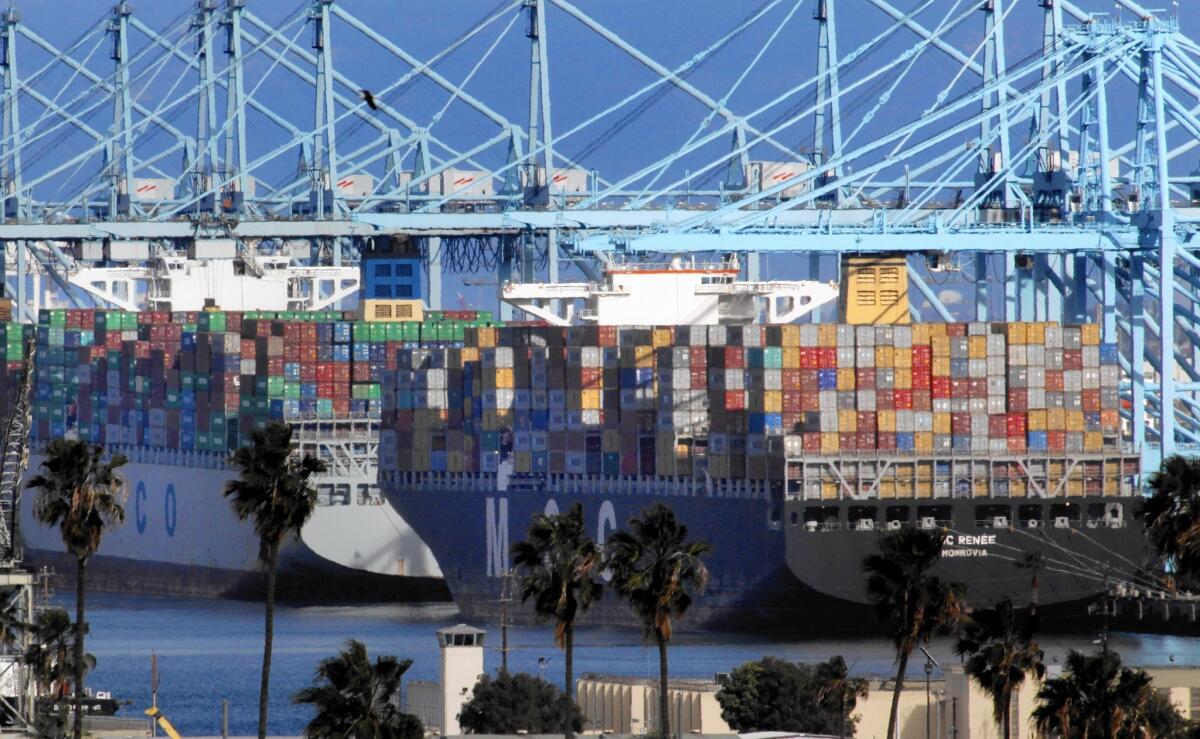Ports dispute to have a small effect on economy

- Share via
The short-term economic impact of the recent labor standoff at West Coast ports will be small, according to a new economic forecast, but the ports face a long-term struggle to remain competitive in the rapidly changing realm of global trade.
Many businesses in California, particularly those tied to agriculture, suffered from missed orders and produce spoiling on docks. But many other shipments were simply delayed rather than lost entirely, according to the quarterly UCLA Anderson Forecast.
The report estimates that backlogs during the labor dispute between shipping companies and dock workers — resolved late last month — will cause slightly slower economic growth in the state for the first three months.
“We’re talking about tenths of a percent — very small stuff,” said Jerry Nickelsburg, a senior economist with the Anderson Forecast who specialized in the California economy. “California is a $2.2-trillion economy, so it’s hard to get any big numbers based on a relatively short labor dispute.”
Particular industries could end up with substantial losses, however, including, for example, retailers who deal in clothing lines tied to specific seasons.
“The impact in some industries will be dramatically greater than others,” said Alan Whitman, a Pasadena-based managing director at Morgan Stanley who does portfolio planning.
Looking ahead, the UCLA report raises questions about the possibility of businesses diverting goods from U.S. West Coast ports to other parts of the country.
The much-anticipated widening of the Panama Canal, scheduled for completion in 2016, would give shipping companies the option to deliver cargo on larger ships to ports on the East and Gulf coasts. Two Pacific ports in British Columbia and another in Michoacan, Mexico, offer other alternatives.
But experts say that businesses that use West Coast ports will continue to focus on daily costs rather than fear of a port shutdown. While many are now upset about the delays, that will fade, said Jock O’Connell, an international trade economist with Beacon Economics.
“You get over your frustration and you pay more attention to your bottom line,” he said.
The risk of port slowdowns caused by labor strife is not confined to the Pacific. In late 2012, the East Coast longshoreman union authorized a strike that spooked retailers across the country. Canadian ports have been dealing with a labor dispute with the nation’s rail workers, and the Mexican military took over the Michoacan port in 2013 in a bid to drive out drug cartels.
In addition, other major changes are under way in international trade. A growing fleet of so-called megaships — some of which can carry up to three times more containers than traditional vessels — are larger than the planned capacity of the widened Panama Canal.
That means U.S. West Coast ports such as Los Angeles and Long Beach would remain the natural option for what is expected to be a growing share of trans-Pacific trade.
“Not only will the shipping costs to the West Coast ports be lower due to the shorter distance traversed, but also due to the increased efficiency of the vessels carrying the cargo,” the UCLA report found.
While the Panama Canal is expected to be a major boost for some companies on the Gulf Coast and Midwest — such as those shipping petroleum or agricultural products across the Pacific — many shippers will still move faster through the West Coast ports.
It cites a U.S. Department of Transportation report that found goods traveling from East Asia to Dallas, for example, would arrive four days earlier going through ports in Los Angeles or Long Beach than if shipped through the Panama Canal to Houston.
“The more time-sensitive the goods, the less attractive diversion would be,” according to the report.
More to Read
Inside the business of entertainment
The Wide Shot brings you news, analysis and insights on everything from streaming wars to production — and what it all means for the future.
You may occasionally receive promotional content from the Los Angeles Times.










